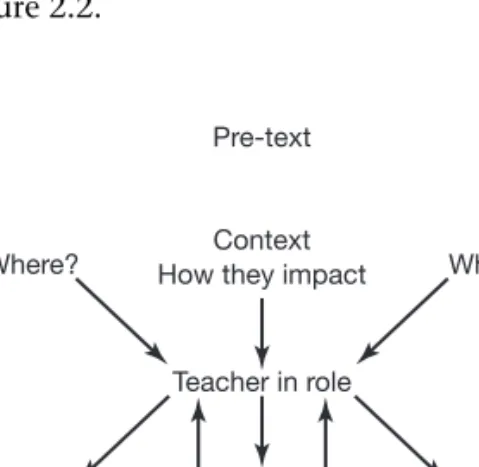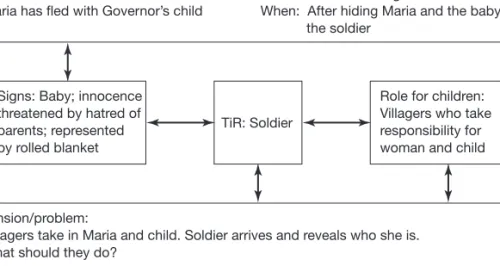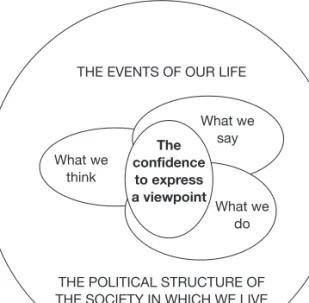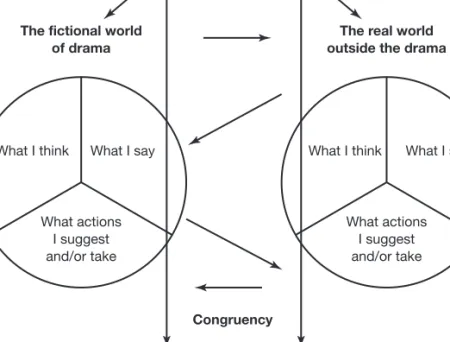There is now a general recognition among teachers that, despite the good intentions behind including speaking and listening in curriculum skills, the normal culture of the classroom is such that any practice of these skills is limited by the narrowness and rigidity of that same culture: teachers use the language of the teacher in the classroom and listen to their students from their position of authority; and in turn the students respond in their role as 'learner' and, listening to each other, guide as one 'learner' to another 'learner', their roles defined and demarcated. 1 How a teacher should go about playing a role and, just as important, how to effectively use 'coming out of the role'.
Introduction
It's helpful to look through some of the dramas before reading the 'how to'. Look especially at 'The Governor's Child', 'The Wild Thing' and 'The Victorian Street Children' or 'The Workhouse', which are used in the chapters on planning, inclusion etc.
Conventions Used in the Text
For In the moments of decision or Both parties can express alley in front of TiR walks slowly down example when Maria difficult conflicting ideas of role opinions. Strategies/Techniques for use in Drama Forum7 An Adaptation of Augusto Where to Be Usually later in a play They take the role collectively in the.
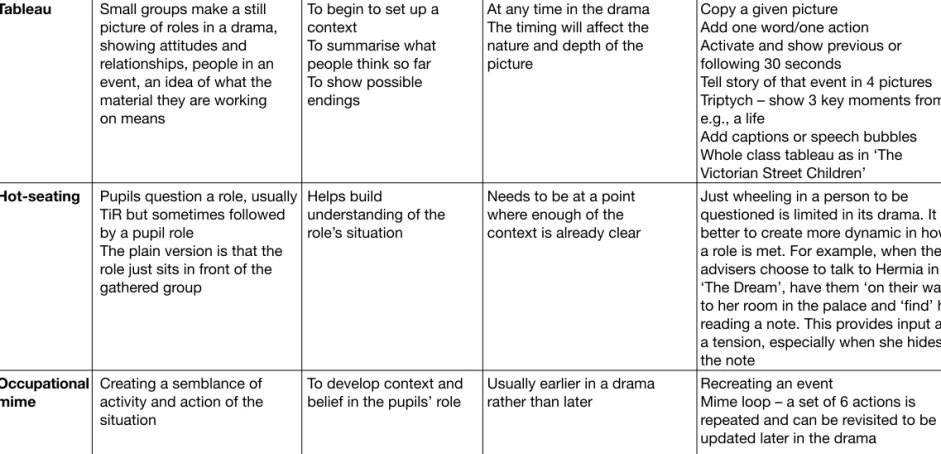
Part One
How to Approach Speaking and Listening through Drama
1 How to Begin with Teacher in Role
Why use teacher in role?
In this case, step out of role again and talk about what the class saw and heard:. In either case, once the classes have speculated enough, they'll have questions for Hermia, and you'll have an interesting way to start telling them the basic situation at the beginning of A Midsummer Night's Dream.
Teacher as storyteller
For another example of the simple use of hot-seating, see the Tim the Ostler section in the drama "The Highwayman." It is essential that the teacher stops and gets out of the role and reflects with the class on what has been said, but so is the more traditional way of reading from a book.
Teaching from within
The rat shooter 'writes' the points and then asks the class/family if they can come to the mayor to help solve the case. It's not, I'll teach you by telling you what you need to know – the style of a lot of classroom teaching.
The requirements of working in role
Disturbing the class productively
Responding to your class
There are five basic types of roles and most of them can be illustrated from the drama 'Dream'. Intermediate role This is often a messenger or intermediary, like the role of the servant in the drama 'Dreams'.
Summary of points to consider
Finally we need a person to be a spokesperson to tell the mayor what you all think. I will assume the role of mayor and maintain my chain of office.
2 How to Begin Planning Drama
With this organic nature, there are opportunities for the class to contribute to the way the drama plays out. We have to plan gaps for students' ideas, we have to be careful not to take the students out of the drama.
The frame of a drama
Therefore, we must consider that drama planning is a creative and dynamic activity that is not carried out simply by following a set of procedures. Within the drama, there must be a balance between the freedom for new possibilities and decisions for the children and the teacher structure that provides the constraints and necessary dynamics of the work, the stage that holds it.
An example of thinking through a plan
So we can use the setting of the room to give clues about what Max is like and what happened to him. Max's return and the confrontation with the Lost & Found agency is the central event of the drama, the moment that the previous phases were.
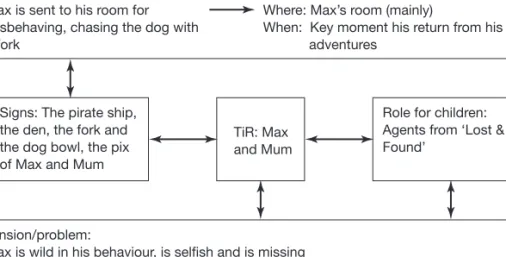
The ingredients of planning
Let's revisit our drama "The Wild Thing" from Where the Wild Things Are. We see this with all the damaged roles in 'Scrooge', Maria in 'The Governor's Child' and with the adoption of the role of the sister in.
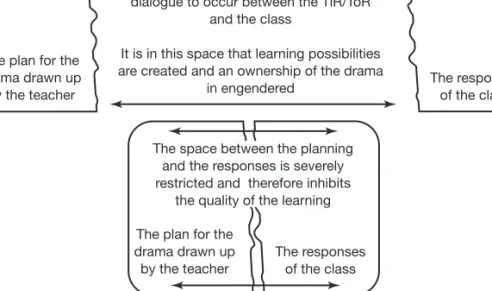
Planning as a collaborative activity
These three elements are directly affected by the constraints or givens that the teacher plans in the performance.
Road testing the first version
Another example of the class offering new ideas about what to do and the form to use when acting out the drama occurred in a series of "Daedalus and Icarus." This method of proceeding can then be regarded as the planned opportunity to explore the issue in future uses of the drama.
Types of drama
For example, when the teacher first road tested 'The Wild Thing' drama, the teacher very aggressively came in as Max and growled to the class in Max's bedroom, I am the King of the Wild Things and will eat you if you make me angry The more you plan the more you will sense the needs of the group and the style that fits.
What about endings to dramas?
Finally – the key decisions
Appendix: Drama starters
- An idea from ‘Romeo and Juliet’
- An idea from ‘Macbeth’
- An idea from ‘Danny Champion of the World’ by Roald Dahl Learning intention Responsibility and children
- An idea from ‘The Hobbit’
Can the map makers solve the mystery, but more importantly they can help Bilbo make one up to fool Gollum. He's not very good at reading the map and Gollum told him the Dragon's Lair was the best way out.
3 How to Generate Quality Speaking and Listening
Authentic dialogue – teacher and pupil talk with a difference
What is speaking and listening ?
Dialogic teaching
As the drama unfolds, the students develop as a community based on the shared experience. Drama provides greater motivation for students, motivation due to their interest in drama's problem solving.
What does dialogic teaching demand of the teacher?
Mistakes can be made and watched because any particular step in the drama can be reworked to make it work better for us. In drama we do it routinely and the learning from the elements of drama becomes even more potent.
How is listening of high quality taught through drama?
It's for both of us, because we have to get out of the palace and the map helps with that. If you can, but I've looked everywhere.. you're not lying to me, are you?
Conclusions
The class paid close attention and listened not only to the teacher, but also their peers, their representatives in the hot seat. Do the Speaking and Listening levels in the National Curriculum match the levels of speaking that pupils can achieve here.
4 How to Use Drama for Inclusion and Citizenship
Of course, drama class is not the only place in school life where inclusion can be encouraged; pupil mentoring, links with parents, links with the wider community, promoting good race relations, promoting good standards of behavior and attendance, pastoral care and study support are venues for inclusivity.
What can drama offer in terms of inclusion?
The concept of drama and keeping pupils safe
As the drama progresses and trust in the teacher and the medium is built, then the students can come closer to the role of the prisoners. This is a shock and may cause anxiety among the class members in the role of servants.
Having a voice in society
Having no voice in society
If there is, we can more easily assess the learning and needs of the pupil. The safe distance allows them to say and do the things they might not say or do in the real world.
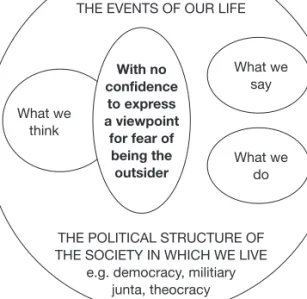
The relationship between inclusion and citizenship
How to approach Citizenship and PSHE through drama
From a summary of the drama, we can see that a number of citizenship issues are immediately put into context and presented to the children. If we examine the thinking behind the planning of the stages of 'The Governor's Child', we can see how through the nature of the tasks, techniques and content it promotes elements of the citizenship curriculum.
5 How to Generate Empathy in a Drama
What is empathy?
For example, let's take a drama/history lesson where we want students to imagine the plight of London's street children in the 1870s (see Chapter 6, How to Connect History and Drama). These universal aspects of the human condition exist through time and we can connect with them through empathy.
A working definition of empathy
Do we really want our class of 10 and 11 year olds to 'put in the shoes' of the desperately poor and malnourished of Victorian urban life? And all of this takes place within the safety of so-called worlds without the consequences of the real world.
The components of empathy
It is in this statement that we can make the connection between empathy, learning and drama, because if we can generate empathetic behavior in pupils through pretend play from imagined realities, they can not only learn from each other, but also their empathic inquiry and refinement . skills.
An example of structuring drama for empathetic response
In the next part of the drama, the students are told that a new inmate is expected and that they must attend her introduction to the workhouse. Events that led to their investigation of the Workhouse Master The students share the experience of witnessing the induction of a new inmate.
Can we plan for generating empathy?
Of course, the nature of the response can vary from simple sympathy with Martha's plight to a more dynamic response to help the person by initiating actions to help. What structuring an empathic response does is enable you to diagnose an aspect of social health within the classroom, or within groups within the classroom, for example, boys and girls.
6 How to Link History and Drama
A problematic alliance
Dressing up to go back in time
Using drama to make meaning of the past
Balancing the tensions – stories and history
Photographs and artefacts are a key approach as they can capture students' attention. The subject is sensitive, the plight of the poor and even more pressing, poor children.
Setting up a historian’s frame
It is important to clarify some of these issues but at the same time not tell the whole story and thus maintain the interest of the class. This question is there to assess students' knowledge at this early stage of learning.
Meeting the boys in the photograph
Away from the rest of the class (you can do this during a break or lunch), those who have decided to be the boys meet you. To maintain tension, this fear must be signaled to the rest of the class.
Whole class participation – a sculpture of children living on the streets
The framework of visitors to a museum located in the future can be established through TiR as a museum curator. As half the class watches, the teacher taps each student on the shoulder and they express their thoughts.
Whole class improvisation
The distance is achieved by one half of the class supporting their representation of the street children through the sculpture and the other half framed by visitors' idea of a museum set in the future. They tap into the plight of the street children by acknowledging the lack of understanding of their position embodied in the role of teacher.
History as a metaphor for now – the global dimension
The class took a stand that exposed the ignorance and condescending attitude of the rich gentleman. The lesson is structured to ensure that their inclusion and their responses are spontaneous and genuinely presented from the point of view of the roles they represent.
7 How to Begin Using Assessment of Speaking and Listening (and Other
What is assessment?
How can we promote better speaking and listening if we do not assess and reflect on changes in students' treatment of the medium. These considerations have driven our use of drama and speaking and listening assessment for many years.
What do you look for?
Where speaking and listening is assessed, there is a tendency to assess it not as an interactive situation, but as a very narrow construct, something that is not actually speaking and listening at all – class talk. One student's talk with the rest of the class usually does not involve dialogue, except perhaps at the end when there may be questions.
What is the purpose of the assessment?
How do we collect data more formally?
The participating lesson teacher can also record what they saw and understood. To develop speaking and listening, we need to treat the class as colleagues.
Other issues to consider
Evidence-based judgments need to be made about speaking and listening, and learner profiles built on the thinking and empathy shown during the drama. If you consider the example later in this chapter, the teacher's responses and management of language opportunities are crucial in producing quality class contributions.
Capturing the samples of speaking and listening
Neil introduces the topic and immediately the tension in the situation can be raised. There are other models for recording what is created using current technology to freeze moments of the drama.
Talk for writing – the wholeness of communication
The task was to write down arguments for or against helping Maria and the child, who are being pursued by the soldiers. We firmly believe that Maria and the child are innocent, and we will always support her.
Part Two
The Dramas
The Governor's Child' - based on 8–11 Language of the community - and on the endangered community of the Caucasian Chalk Circle - the outsider by Bertolt Brecht Language regarding the power of one. The Highwayman' Themes of Choices in Poetry within a Romantic Love-based personal historical context poem of and 'The Hero' relationships (changing values/ . Alfred Noyes Author's viewpoint mores).
Timing the dramas
Learning objectives
Contracting into dramas
Gender of roles
The Wild Thing’
A drama based on Where the Wild Things Are by Maurice Sendak
- Negotiate doing drama
- TiR as Organiser of Lost & Found
- TiR as Mother (Mrs Jackson)
- Narration
- At the room
- Making sense of the evidence
- Hot-seating Mother (Mrs Jackson)
- Role on the wall 1: Max
- Narration
- TiR as brother/sister
- Narration
- Role on the wall 2
- TiR as Max (main role)
- Max on the island
- Extra challenge
- Giving advice – tackling Max and Mother
TiR as organizer of Lost & Found. the Lost & Found logo on the wall and in the clipboard). The Lost & Found agents move in and surround the figure to make sure whoever it is can't get away.
Structured summary
Found investigators have to calm him down and try to get him to see what he's doing and that his mother missed him, etc. If the investigators don't go, Max has to yell at his mother and ask her to get rid of them and then disappear herself.
Additional material for other drama starters based on Where the Wild Things Are
Children as experts on Wild Things
Additional material for other drama starters based on Where the Wild Things Are. 2) Set up an expedition to study wild things in their habitat Each group is responsible for a different aspect of the expedition. He goes to the experts to tell them he knows where to study new Wild Things live.
The Boat Builders Learning objectives
They find a very sad boy sitting on the shore, but who pretends to be very happy on the Island when they approach.
Daedalus and Icarus’
A drama based on the Greek legend
- Pictures of the Palace of King Minos at Knossos Show and discuss these. Our drama begins here
- Set up the Palace and routines
- TiR as Minos
- Observed event
- Minos has a plan
- TiR as Icarus
- TiR as Daedalus
- Facing Daedalus
- Facing Minos
- Final stage (especially if you do not have time for the above)
OoR, the servants are all with Icarus in the room looking at the file when this happens. Dedalus reveals to the servants that he is being forced to invent war machines for Minos and does not want to do it.
Structure summary
The Snow Queen’
A drama based on the story by Hans Christian Andersen
- TiR as Chief Superhelper
- ToR: They discuss what they need to write to protect them
- TiR as Chief Superhelper
- Map of the Land of Ice and Snow
- Set up the bridge
- TiR as Gerda
- Meeting the Stranger
- Opening the mysterious box
- Narrative action
- The Snow Queen’s castle
- Prepare to talk to Kai
- Task – persuading Kai
- TiR as the Snow Queen
- Forum between Gerda and Kai
- Images of the fall of the Queen
This will contain the information from the letter and the location of the Snow Queen's castle. OoR: In the next part of the drama, we will make pictures of the dangers the super helpers and Gerda had to overcome on the journey.
Appendix: other possible Kai roles
Of course, the Snow Queen needs to be made to face his monstrosity, perhaps to see the need to let him go (if she doesn't succumb to the need to change). Kai needs to be told what the problem is with his situation and maybe how Gerda feels about losing him.
Charlie’
A drama based on Voices in the Park by Anthony Browne
- TiR as Co-ordinator for Volunteers
- Set up the class as volunteers
- Narration
- TiR as Charles
- Dealing with Charles
- Groups
- TiR as Charles returns
- Smudge’s letter
- Possibilities
- Forum theatre of key issue (one or more?)
Meet the class as a coordinator for volunteers who come to help maintain the park. The class can try to confront him about Smudge or they can encourage him to confront his mother (move the drama directly to structure point 12).
The Maasai Boy’
- Negotiate doing drama 2. Narration
- Tableaux
- Pupils’ role – ‘Mantle of the Expert’
- The statue
- TiR as Kilesi – the Kenyan boy
- Kilesi’s statue
- The Organiser’s position
- Who owns the statue?
- Mr Torrance’s request
When they have to look at this, they have to consider: What is the purpose of the statue. Set up a forum theater with TiR while mr. Torrance watches from the participants and imitates the use of the phone.
The Governor’s Child’
A drama based on The Caucasian Chalk Circle by Bertolt Brecht
- Negotiate doing drama 2. Drawing and setting scene
- Narration
- TiR as Villager
- The girl (Maria) comes to the village
- The entry of Maria
- Hot-seating Maria
- Sociogram of attitudes to her
- Narration
- TiR enters as the Villager (rings the bell)
- TiR as the Soldier
- Sociogram about Maria Compare to the first
- The Soldier returns
- Group tableaux
She goes to her brother's house over the mountains, to safety because of the riots in the city. OoR: How do they get him out of town so they can decide what to do.
Other possible work to develop this drama or as separate work
The Highwayman’
Based on the poem by Alfred Noyes
- Introduce the poem
- Meeting of the historians and the present landlord
- Back into role
- TiR as Tim the Ostler
- They hot-seat Tim
- Create Tim’s room over the stables
- Children become the walls of the room
- TiR as Bess
- Tableaux
- Overhead conversation
- Thermometer line of whether she should go or not (Optional: Set up the class to thought-track Bess.)
- Forum of Tim with the Highwayman
- Tableaux
TiR: What could be the layout of the inn during this period, according to what is described in the legend. This is a floor plan of the oldest parts of the inn as we know it, and probably the site of the stable.
The Victorian Street Children’
- Key questions to introduce the drama What is a historian?
- Looking at a photograph
- TiR as Edward Fitzgerald
- Establishing the task
- Setting up the tableau/questioning of the boys This needs to be done in two parts
- Add the information gained to the ‘What do you know…?’ chart
- Question the photographer, Thomas Barnes
- Whole class sculpture and thought-tracking
- Meeting the wealthy gentleman
- Class discussion
Negotiate with the five volunteers in the class to take on the role of the boys in the picture. Gather the class and negotiate that they will all represent the street children in the next part of the drama.
The Workhouse’
- Introduce the focus of the drama, the workhouse
- Role for the class
- TiR as Mards, the Workhouse Master
- Task – visualising the workhouse
- TiR as Crimmins Crimmins approaches
- Setting up of Mards’s office
- TiR as Crimmins
- Thought-tracking Martha
- Forum theatre – Martha
- TiR as Mards
- The commissioners have a chance to speak to Mards about the induction OoR: What questions or things do you want to say to Mr Mards at this point?
- Introducing the research section: turning the workhouse rules into tableaux
- TiR as Mards
- TiR as Commissioner
- Forum theatre with TiR as Mards
- Workhouse reality
- Setting an agenda for reform
We're going to make the Master of the Workhouse room and I want you to tell me what's in there. ToR: In the rest of the drama you will take on the role of inmates to see life in the workhouse from their perspective.
The Egyptians’
- OoR introduce the idea of an expedition
- TiR as Head of British Egyptology Expedition
- Current knowledge and misconceptions
- Introducing the idea of a shift in time
- TiR as the High Priest’s servant
- Group task – making the tableaux
- TiR as the High Priest enters to inspect the work
- Creating a ritual
- Setting up the entrance of Geb
- Hot-seating Geb
- Return of TiR as the High Priest
- Thought-tracking Geb
- TiR as Geb asks for their help
- TiR as Selquet
- To whom do they wish to speak?
- Final picture and conscience alley
- Sociogram of Geb and Selquet
We now go back to the story to listen to the High Priest's servant. OoR: What does the High Priest mean - we must have the ritual of the blessing.
Macbeth’
A drama based on Macbeth by William Shakespeare
- Negotiate doing drama 2. Introduction
- The focus of the drama
- TiR as Macbeth
- Sociogram – showing reaction to Macbeth at this stage 6. TiR as Chief Steward returns
- Recap last session 8. After the banquet
- Servants discuss what they have seen with the Steward What does this mean? What has he seen?
- The Steward provides more evidence
- The servants are threatened with discovery
- Repeat mime loop and develop
- Macbeth comes looking for the letter
- Set up the Queen’s bedchamber
- Ending possibilities
Introduce symbols that can be used in the representation; the themes and symbols in the piece suggest possibilities - the gold-covered throne/candle in a candlestick/red cloth. A whole group performance at the coronation of the new king, with an image of the overthrown Macbeth somewhere.
Appendix: The Witch
- An arrival at the castle
- Set up the ritual Standing in a circle
- Reflecting on the moment
- They take the mirror to Macbeth He becomes frightened by what he sees in it
Assign a volunteer or volunteers to open the door, gathering the rest of the class as observers. The point is for the servants to open the package/pick up the mirror and see what they think it all means.
